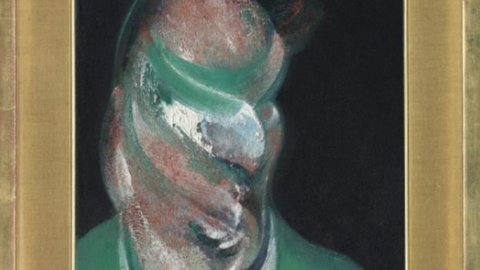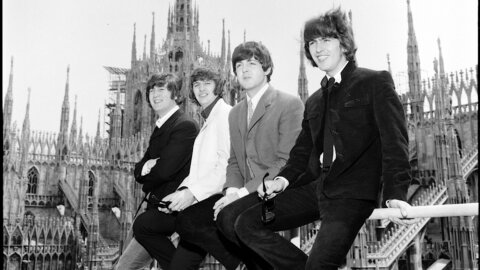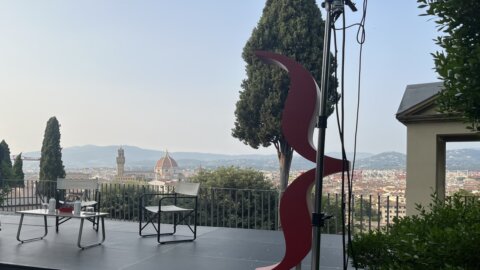As Francis Outred, Christie’s Head of Post-War & Contemporary Art, Europe, says: “Following on from Christie’s success in making a world record for Bacon’s The Three Studies of Lucian Freud, 1969, which sold in November 2013 for $142.4 million, the highest price ever paid at auction for a work of art, Study for Head of Lucian Freud connects three titans of the arts from the 20th century, and draws together Bacon, Freud and Dahl at the height of their artistic powers.”
Dahl once remarked that, ‘You cannot begin to appreciate any work of art in the true sense until you have studied the personalities involved and the struggles they had.’ 3 Over the years, the close friendship and rivalry between Bacon and Freud has been well documented, whereas Dahl’s friendship with Bacon has never been as well known. Even though these two creative geniuses worked in different fields, they shared a keen sense of the macabre, which can be seen in both of their work: where Bacon used his rapid, impulsive brush marks to create an intimate and startlingly animated portrait, Dahl used his pen to create unforgettable stories that sear the imagination with provocative and affecting images.
Dahl and Bacon had much in common. Both were enigmatic outsiders who were hard to pin down and liked to work in small, claustrophobic spaces. Both also aroused controversy and fascination in their public and private lives. Dahl maintained a close friendship with the artist for many years, often inviting him for dinner at his Buckinghamshire home Gipsy House in the 1970s and 1980s, where they bonded over their mutual admiration for the work of Van Gogh, among other topics.
Dahl, who was also a British spy, fighter pilot and medical pioneer, had an overwhelming passion for art. ‘I had become an enthusiastic collector of pictures as soon as World War II ended,’ he wrote. ‘Each time I sold a short story, I would buy a picture when there was a bit more money in the bank, and I began buying pictures for keeps.’4He first became familiar with Bacon’s work through his friend, the artist Matthew Smith, and subsequently when Bacon was shown alongside Smith and Victor Pasmore in a 1958 Arts Council touring exhibition entitled Three Masters of British Painting. Dahl was immediately impressed by what he saw as the blend of economy and profound emotion in [Bacon’s] painting’, and immediately declared him a ‘giant of his time’.4 He went on to buy four Bacon canvases between the years of 1964-67 and subsequently sold all except Study for Head of Lucian Freud, which retained its undisputed place in his collection and then the family’s after his death in 1990.
Study for Head of Lucian Freud was painted at a time of great happiness in both Bacon’s and Dahl’s lives. For Bacon, his relationship with his muse and lover George Dyer was at its peak, his paintings were gaining international recognition and he was being offered exhibitions at major museums around the world. For Dahl, 1967 marked the fruition of a series of professional triumphs including a lucrative deal with UK publishing house George Allen & Unwin for the UK publication of James and the Giant Peach and Charlie and the Chocolate Factory. Within weeks both books sold out and a subsequent reprint sold out as well. Dahl was also finding success in Hollywood, where he wrote screenplays for the James Bond film You Only Live Twice and for Chitty Chitty Bang Bang. It was in this ebullient atmosphere that Dahl was able to act in earnest on his appreciation for art, and specifically for Bacon.
From 1961 Bacon employed the fourteen-by-twelve inch canvas format exclusively for an unprecedented portraiture cycle depicting a close coterie of friends, as well as his own self-portraits. It was a format and fellow painter, Lucian Freud, played a central role within the artist’s oeuvre. From as early as 1951, Freud and Bacon began to capture their friendship in portraits – one undertaking a painting or a drawing of the other. Bacon’s earliest Portrait of Lucian Freud, 1951, (Whitworth Art Gallery, Manchester) was his first portrait to acknowledge the name of his sitter. As Freud said of Bacon, ‘He talked a great deal about the paint itself, carrying the form and imbuing the paint with this sort of life. He talked about packing a lot of things into one single brushstroke, which amused and excited me, the idea of paint having that power.’
Preferring to paint his subjects from photographs rather than life, Bacon commissioned John Deakin to take photographs of Freud. From these, with each masterful sweep of his brush in Study for Head of Lucian Freud, Bacon paid homage to his friend and rival and to their shared passion for painting. Conveying the intimacy of their relationship, Bacon succeeds in expressing a sense of Freud’s character, his inner resolve, pride and vitality in paint.
Part of the proceeds from the sale of this painting will enable the Dahl family to continue the philanthropic work thatRoald began and that the family has expanded over the last twenty years, including:
Roald Dahl’s Marvellous Children’s Charity helps seriously ill young people to deal with their conditions in many different ways, including with the provision of fifty specialist children’s nurses around the UK. In the spirit of Roald Dahl, it aims to give assistance in an imaginative, inventive and impactful manner. “We are proud that so many people support our cause,” says the charity’s Chief Executive Dr. Richard Piper, “but our greatest supporter remains the Dahl family, which continues Roald’s own generous philanthropic tradition, and have helped to improve the lives of nearly a quarter of a million children in the UK.”The Roald Dahl Museum and Story Centre—a registered charity that gets approximately 70,000 visitors a year—is anchored by the family’s gift of the Roald Dahl archive, which it uses to fulfill it’s mission of to engaging children in writing and story creation. Since Roald’s death, the Dahl family has given more than £8 million pounds to these two charities.
Viewing:
Basel: 18 June, Hotel Les Trois Rois
London: 27 June (by appointment only), 28 June – 1 July
Auction:
Post-War and Contemporary Art Evening Auction, 1 July 2014, Christie’s King Street





